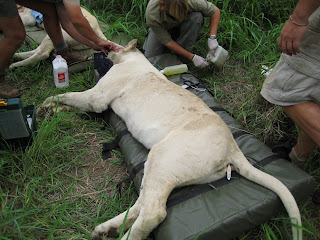

Two white lions were scratching their face since 2 days, possibly caused by fleas, mites or sun burning. Extensive scratching often causes a huge secundary dermatitis. We see this very often in companion animals, especially labradors, but we never saw it in lions before. The white coat of these lions may have an influence in the cause, as the 3 other lions of the pride, all with a normal tawny colour, did not show any signs. Maybe the fleas prefered a white coat or the skin was more sensitive for sunlight? Sun burn with secundary dermatitis is often seen in house cats with a white coat.
We have immobilizated these two lions to clean up and disinfect the wounds, and to inject the lions with anti-parasite treatment, antibiotics, anti-inflammation and multi-vitamins. A few days later an improvement was already seen. In veterinary practice, especially when dealing with wild animals in a field situation, the focus is that the animals get better, with not always knowing the exact cause.
White lions are not albinos. Their white colouration is similar to blue eyes in humans, which is similarly due to a recessive gene. The Greater Timbevati and Southern Kruger National Park region is the only place in the world where these special lions are found in the wild. Since the 70's white lions are artificially taken from the wild for captive breeding projects because they were expected not to survive in the wild. The Global White Lion Protection Trust has recently released white lions back into the wild as part of the conservation efforts to protect these mysterious animals. White Lions also have a strong cultural and spiritual value for the indigenous Shangaan people in the region. See for more information:
http://www.whitelions.org/


The release back into the wild...
 This sable antilope was found in the morning walking lame with a porcupine needle in her leg. She clearly won the fight: a porcupine was found dead close the her in the same morning. The female sable antilope was immobilized and the needle was removed. The wound was washed and antibiotics and a painkiller were given. Soon after treatment she was walking well again.
This sable antilope was found in the morning walking lame with a porcupine needle in her leg. She clearly won the fight: a porcupine was found dead close the her in the same morning. The female sable antilope was immobilized and the needle was removed. The wound was washed and antibiotics and a painkiller were given. Soon after treatment she was walking well again.
















